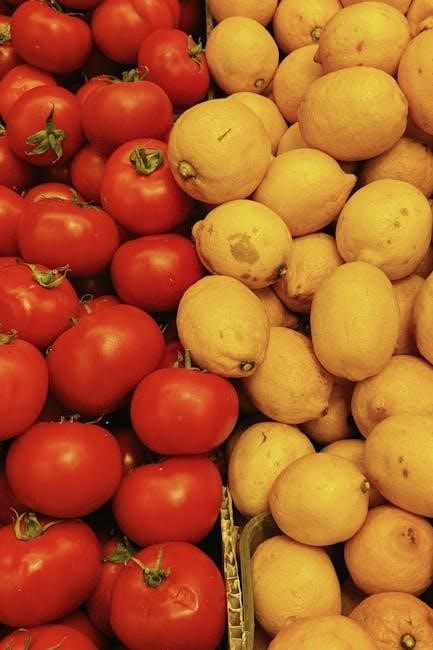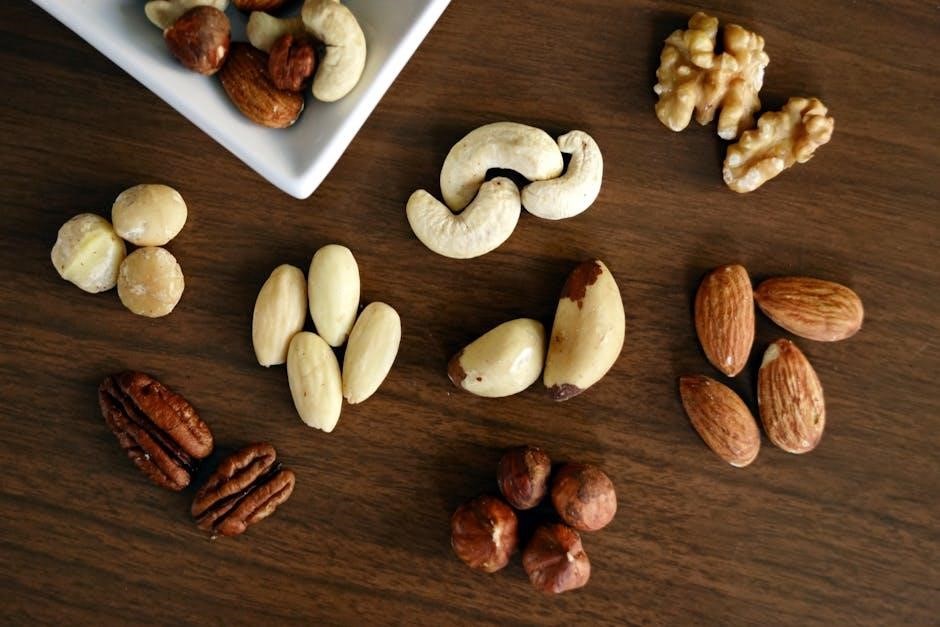
printable pancreatitis diet pdf
A printable pancreatitis diet PDF offers a structured approach to managing symptoms through dietary adjustments, helping alleviate nausea, vomiting, and pain while promoting healing and overall well-being effectively․
What is Pancreatitis?
Pancreatitis is inflammation of the pancreas, an organ behind the stomach that produces digestive enzymes and hormones like insulin․ It can be acute (short-term) or chronic (long-term), with symptoms including severe abdominal pain, nausea, vomiting, and diarrhea․ Acute pancreatitis may resolve with treatment, while chronic pancreatitis leads to permanent pancreatic damage, often causing malabsorption of nutrients and diabetes․ Common triggers include alcohol abuse, gallstones, and high-fat diets․ Managing pancreatitis requires medical treatment and dietary adjustments to reduce pancreatic stimulation and alleviate symptoms․ A structured diet plan, such as a printable pancreatitis diet PDF, plays a crucial role in managing the condition by guiding food choices that avoid irritants and ensure proper nutrition․
Role of Diet in Managing Pancreatitis
Diet plays a pivotal role in managing pancreatitis by reducing pancreatic stimulation and alleviating symptoms․ A well-structured diet helps minimize digestive enzyme production, preventing further inflammation․ By avoiding high-fat, high-fiber, and trigger foods, individuals can reduce pain and discomfort․ The diet focuses on low-fat, low-fiber foods initially, gradually introducing more nutrients as tolerance improves․ Clear fluids are often recommended in acute phases to rest the pancreas, progressing to soft, easily digestible foods․ A printable pancreatitis diet PDF provides a clear guide, ensuring consistency and adherence to these dietary recommendations․ Proper nutrition supports healing, prevents malnutrition, and helps manage complications like diabetes, making it essential for overall health and symptom control in both acute and chronic cases․

Benefits of a Printable Pancreatitis Diet Plan
A printable pancreatitis diet plan provides a clear, structured guide, helping individuals track meals and adhere to dietary recommendations, ensuring effective symptom management and improved overall well-being through consistency․
Why Use a Printable Diet Plan?
A printable pancreatitis diet plan offers a clear and organized guide, making it easier to manage symptoms and adhere to dietary recommendations․ It provides a structured format with meal ideas, portion sizes, and nutritional advice, helping individuals stay on track․ The portability of a printable plan allows for easy reference at home, in the grocery store, or while dining out․ It also serves as a tool for tracking progress, enabling better monitoring of food intake and symptom responses․ A printable plan can be easily shared with healthcare providers for feedback and adjustments․ Additionally, having a physical copy can motivate adherence to the diet, as it serves as a constant reminder of the importance of dietary changes․ This practical resource simplifies the complex task of meal planning, ensuring that individuals with pancreatitis can focus on their recovery and well-being with confidence and clarity․
Advantages of a Structured Diet Plan
A structured diet plan provides clarity and organization, making it easier to adhere to dietary guidelines tailored for pancreatitis management․ It ensures meals are balanced, nutrient-rich, and low in triggers like high-fat or high-fiber foods․ By following a structured plan, individuals can avoid decision fatigue and reduce the risk of dietary mistakes that might worsen symptoms․ This approach also helps track nutritional intake, ensuring adequate consumption of essential vitamins and minerals․ A structured plan can be easily customized to accommodate personal preferences and tolerance levels, making it more adaptable and sustainable․ Over time, this consistency supports better digestion, symptom relief, and overall health improvement․ Moreover, a structured diet plan serves as a valuable educational tool, teaching individuals about appropriate food choices and portion control, empowering them to manage their condition effectively in the long term․

Understanding the Pancreatitis Diet
The pancreatitis diet focuses on reducing pancreatic stress through tailored dietary adjustments, progressing from clear fluids to regular meals, and is effectively guided by a printable PDF plan for easy adherence and management․
Key Principles of the Pancreatitis Diet
The pancreatitis diet is designed to minimize pancreatic stress and manage symptoms effectively․ It typically begins with clear fluids and progresses to low-fat, low-fiber foods before gradually reintroducing normal meals․ Avoiding high-fat and high-fiber foods is crucial to prevent irritation․ Small, frequent meals are often recommended to ease digestion and reduce nausea․ The diet focuses on nutrient-rich options, such as lean proteins, low-fat dairy, and easily digestible carbohydrates, while avoiding alcohol and spicy or fatty foods․ Staying hydrated is also emphasized to support recovery․ A printable PDF plan can help guide this process, ensuring meals are balanced and tailored to individual needs․ By adhering to these principles, patients can better control symptoms and promote healing while maintaining proper nutrition․
Phases of the Diet: Clear Fluids to Regular Diet
The pancreatitis diet is typically divided into phases to ensure gradual and safe reintroduction of foods․ The initial phase involves clear fluids, such as broth or electrolyte-rich beverages, to minimize pancreatic stimulation․ Once tolerated, the diet progresses to low-fat, low-fiber foods like toast, plain rice, and bananas․ This phase helps ease digestion while avoiding irritation․ As symptoms improve, higher-fiber and higher-fat foods are slowly introduced, followed by a return to a regular diet if well-tolerated․ Each phase is designed to reduce discomfort and prevent relapses․ A printable PDF guide can provide a structured plan, outlining meal options for each stage and ensuring a smooth transition․ This approach helps manage symptoms effectively while meeting nutritional needs and promoting recovery․

Recommended Foods for Pancreatitis
Recommended foods include low-fat, low-fiber options like bananas, applesauce, and lean proteins such as chicken or fish․ Whole grains and steamed vegetables are also encouraged for easy digestion and nutrient balance․
Low-Fat and Low-Fiber Foods
Low-fat and low-fiber foods are essential for managing pancreatitis, as they minimize pancreatic strain․ Opt for lean proteins like chicken, turkey, or fish, and low-fat dairy products like skim milk or yogurt․ Vegetables such as cooked carrots, green beans, and spinach are ideal, as they are gentle on the digestive system․ Fruits like bananas, applesauce, and berries are also recommended due to their easy digestibility․ Whole grains like white rice, oatmeal, and whole-wheat bread provide necessary nutrients without excessive fiber․ Healthy fats, such as avocado or olive oil, should be consumed in small amounts․ Avoid high-fat or fried foods, as they can trigger symptoms․ A structured diet plan, like the printable pancreatitis diet PDF, can guide you in selecting these foods effectively, ensuring proper nutrition while managing the condition․
High-Carb, Low-Protein Options
High-carbohydrate, low-protein foods are beneficial for individuals with pancreatitis, as they are easier to digest and reduce pancreatic strain․ Incorporate complex carbs like white rice, pasta, oatmeal, and whole-grain bread, which provide sustained energy without overburdening the pancreas․ Fresh fruits such as bananas, apples, and berries are excellent choices due to their high carb content and ease of digestion․ Vegetables like cooked potatoes and squash are also recommended for their carbohydrate-rich profiles․ Protein intake should be moderate, focusing on low-fat sources like lean meats, eggs, or tofu․ Avoid high-protein foods that are difficult to digest․ A printable pancreatitis diet PDF can offer tailored meal plans, ensuring a balance of nutrients while adhering to these dietary guidelines․ This approach helps manage symptoms and supports overall digestive health effectively․

Foods to Avoid in Pancreatitis
Foods to avoid include high-fat, high-fiber, spicy, and processed items, as well as alcohol and caffeine, which can trigger symptoms and worsen inflammation․
High-Fat and High-Fiber Foods to Limit
High-fat and high-fiber foods can exacerbate pancreatitis symptoms by triggering inflammation and discomfort․ Foods like fried items, red meat, and full-fat dairy should be avoided, as they contain excessive fat that can irritate the pancreas․ Similarly, high-fiber foods such as nuts, seeds, and whole grains can cause digestive strain, worsening symptoms․ Limiting these foods helps reduce pancreatic stress and supports healing․ Opting for low-fat, low-fiber alternatives is essential for managing the condition effectively․ A printable pancreatitis diet PDF can provide a detailed list of foods to avoid and suggest healthier options for meal planning․ By adhering to these dietary restrictions, individuals can better control their symptoms and improve overall well-being․ This structured approach ensures that nutrition remains balanced while minimizing discomfort and promoting recovery․
Triggers for Pancreatitis Symptoms
Identifying and avoiding triggers is crucial for managing pancreatitis symptoms effectively․ Alcohol consumption and smoking are well-known triggers that can worsen inflammation and damage the pancreas․ High-fat and high-fiber foods, as well as processed or spicy foods, can also irritate the pancreas, leading to pain and discomfort․ Additionally, stress and lack of sleep may exacerbate symptoms, making it essential to maintain a balanced lifestyle․ A printable pancreatitis diet PDF can help individuals identify these triggers and provide guidance on avoiding them․ By eliminating these factors, individuals can reduce the frequency and severity of symptoms, promoting healing and overall well-being․ Understanding and managing these triggers is a key component of a successful pancreatitis management plan․

Sample 7-Day Meal Plan for Pancreatitis
This structured meal plan guides you through breakfast, lunch, and dinner options, ensuring nutrient-rich, low-fat, and low-fiber meals to minimize discomfort․ Download the printable PDF for easy reference and meal prep․
Breakfast Options
Starting your day with a gentle, nutrient-rich breakfast is essential for managing pancreatitis․ Opt for low-fat, low-fiber options like oatmeal with a splash of non-fat milk or scrambled eggs without added butter․ A smoothie made with low-fat yogurt, ripe bananas, and a touch of honey is also a great choice․ For a lighter option, consider clear fluids such as apple juice or herbal tea․ Avoid high-fat foods like bacon or sausage, as they can trigger discomfort․ If you’re tolerating solids, a small portion of whole-grain toast with a thin layer of jam or a mashed banana can be added․ Portion control is key to prevent overloading your pancreas․ These breakfast ideas are designed to be easy on the digestive system while providing essential nutrients․ For more detailed recipes and portion guides, download the printable pancreatitis diet PDF․
Lunch Ideas
Lunch should focus on gentle, easily digestible foods that avoid triggering pancreatitis symptoms․ Start with clear fluids or low-fat broths like chicken or vegetable broth․ Gradually introduce low-fiber, low-fat options such as steamed vegetables (e․g․, carrots, green beans) or small portions of lean proteins like grilled chicken or fish (without skin)․ A small serving of plain, low-fat yogurt or a mashed potato can also be included․ Avoid fatty or fried foods, as well as high-fiber ingredients․ Portion sizes should be small to prevent overwhelming the pancreas․ For example, a light meal of poached chicken with steamed spinach and a teaspoon of olive oil is ideal․ These lunch ideas are designed to provide nutrition while minimizing discomfort․ For detailed recipes and portion guides, refer to the printable pancreatitis diet PDF, which offers structured meal plans tailored to your needs․
Dinner Suggestions
Dinner should be light and balanced, focusing on foods that are easy to digest while avoiding triggers․ Baked or steamed fish (like cod or tilapia), lean meats (such as turkey or chicken without skin), or tofu are excellent protein options․ Pair these with steamed vegetables like zucchini, carrots, or green beans․ Small portions of low-fat, low-fiber sides, such as mashed potatoes or plain rice, can accompany the meal․ Avoid high-fat, fried, or spicy dishes, as they may worsen symptoms․ For example, a simple meal could include grilled chicken breast with steamed asparagus and a small serving of quinoa․ Ensure all foods are seasoned lightly and without added fats․ These dinner suggestions help maintain nutritional balance while minimizing pancreatic strain․ For more detailed recipes and portion guidelines, refer to the printable pancreatitis diet PDF, which provides structured and easy-to-follow meal plans․

Managing Symptoms Through Diet
A well-structured diet helps reduce pancreatitis symptoms like nausea, vomiting, and diarrhea․ Focus on low-fat, low-fiber meals to minimize pancreatic strain while ensuring proper nutrition and symptom relief․
Reducing Nausea and Vomiting
Managing nausea and vomiting in pancreatitis requires a gentle approach to eating․ Start with clear fluids like broth or electrolyte-rich drinks to stabilize digestion․ Gradually introduce bland, low-fat foods such as crackers, toast, or plain rice․ Avoid heavy, fatty, or spicy meals that can trigger symptoms․ Small, frequent meals are easier on the pancreas and help reduce nausea․ Stay hydrated by sipping fluids slowly throughout the day․ A printable pancreatitis diet PDF can provide structured guidance, ensuring meals are balanced and tailored to minimize discomfort․ By following these dietary adjustments, individuals can effectively manage nausea and vomiting, supporting overall recovery and digestive health․
Preventing Diarrhea and Malabsorption
Preventing diarrhea and malabsorption in pancreatitis involves focusing on a low-fat, low-fiber diet that minimizes pancreatic strain․ Incorporate lean proteins like chicken or fish, and opt for low-fiber carbohydrates such as white bread, rice, or pasta․ Avoid foods high in fat or spice, as they can exacerbate symptoms․ Small, frequent meals can help improve digestion and reduce the risk of malabsorption․ Additionally, staying hydrated with water or oral rehydration solutions can help manage diarrhea․ A printable pancreatitis diet PDF often includes enzyme replacement therapy recommendations, which are crucial for proper nutrient absorption․ Regular monitoring of symptoms and adjustments to the diet plan can help prevent complications and ensure optimal nutritional intake․ By adhering to these guidelines, individuals with pancreatitis can better manage their digestive health and reduce the likelihood of malabsorption and diarrhea effectively․

Lifestyle Tips for Managing Pancreatitis
Adopting a healthy lifestyle is crucial for managing pancreatitis․ Regular exercise, adequate sleep, and stress management can significantly improve symptoms and overall well-being․ These habits complement a structured diet plan effectively․
Exercise and Physical Activity
Regular exercise is essential for managing pancreatitis, as it improves digestion and overall health․ Gentle activities like walking, swimming, or yoga can help reduce symptoms and enhance mental well-being․ These exercises improve blood circulation, which aids in healing and digestion․ However, high-intensity workouts, especially after meals, may trigger pain․ Always listen to your body and rest when needed․ Consistency is key to benefiting from physical activity․ Combining exercise with a balanced diet, as outlined in a printable pancreatitis diet PDF, can further support recovery․ Consult your healthcare provider before starting any new exercise program to ensure it aligns with your condition․ Physical activity, when tailored to individual needs, plays a vital role in managing pancreatitis and improving quality of life․
Importance of Sleep
Sleep plays a critical role in managing pancreatitis by aiding the body’s natural healing processes․ During sleep, the body repairs tissues, reduces inflammation, and balances hormones, all of which are essential for pancreatic health․ Aim for 7-9 hours of quality sleep per night to support recovery and prevent fatigue․ Poor sleep can worsen symptoms like pain and nausea, making it harder to manage the condition․ Establishing a consistent sleep routine, avoiding stimulants before bedtime, and creating a relaxing environment can improve sleep quality․ Addressing sleep disruptions, such as those caused by nighttime pain or discomfort, is vital for overall well-being․ Prioritizing sleep, alongside a structured diet plan like the printable pancreatitis diet PDF, helps maintain a healthy balance and supports long-term recovery from pancreatitis․

Stress Management Techniques
Stress management is essential for individuals with pancreatitis, as stress can exacerbate symptoms and hinder recovery․ Techniques like deep breathing exercises, meditation, and yoga can help reduce stress levels and promote relaxation․ These practices not only improve mental well-being but also support physical health by lowering inflammation and enhancing digestion․ Additionally, engaging in hobbies or activities that bring joy can distract from discomfort and improve mood․ Setting realistic goals and maintaining a structured daily routine can also help manage stress effectively․ Prioritizing stress reduction, alongside adherence to a printable pancreatitis diet PDF, creates a holistic approach to managing the condition and improving overall quality of life․ By incorporating these techniques, individuals can better cope with the challenges of pancreatitis and support their long-term health and well-being․

Downloading and Using the Printable PDF
The printable pancreatitis diet PDF is easily accessible online, offering a clear, structured guide to managing symptoms through dietary adjustments․ Print and use it daily for better adherence and convenience․
Where to Find the Printable Diet Plan
The printable pancreatitis diet plan can be found on reputable health websites and medical resources․ Visit the Premier Gastroenterology website for the “PG20DIET20PANCREATITIS-1․pdf” document, which provides a detailed guide․ Additionally, the National Pancreas Foundation offers a free downloadable PDF as part of their nutrition guide for managing pancreatitis․ Search for “Pancreatic Diet Food List & Example” or “7-Day Meal Plan for Pancreatitis” on trusted health platforms to access these resources conveniently․
How to Use the PDF Effectively
To maximize the benefits of the printable pancreatitis diet PDF, review its content thoroughly․ Start by understanding the key principles and the recommended phases of the diet, from clear fluids to a regular diet․ Use the 7-day meal plan as a guide to plan your daily meals, ensuring you include low-fat and low-fiber foods while avoiding triggers․ Print the PDF and keep it handy for quick reference, marking recipes and tips that work best for you․ Track your progress and adjust the plan as needed to manage symptoms effectively․ For additional support, download the National Pancreas Foundation guide or explore the 4-week Mediterranean-style meal plan for long-term management․ By following these steps, the PDF becomes a valuable tool in your journey to manage pancreatitis and improve your overall health․


Leave a Reply
You must be logged in to post a comment.